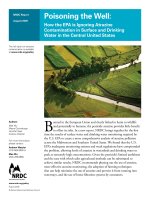5 8 the growing united states
Bạn đang xem bản rút gọn của tài liệu. Xem và tải ngay bản đầy đủ của tài liệu tại đây (3.19 MB, 10 trang )
Fascinating Facts
• Nearly $2 billion in gold was mined in California
before widespread mining stopped.
• Besides California, gold rushes occurred in Australia
(1851), British Columbia (1858), Nevada (1859–60),
Colorado (1850s and 1890s), South Dakota (1876–
78), and South Africa (1886).
• The word touchstone means a test that shows if
something is real. The original touchstone was a black
stone that, when rubbed with a piece of gold, showed
if the gold was pure.
Genre
Nonfiction
Comprehension Skill
Compare
and Contrast
Text Features
• Sidebars
• Captions
• Song
Scott Foresman Social Studies
ISBN 0-328-14897-0
ì<(sk$m)=beijhe< +^-Ä-U-Ä-U
The Growing
United States
by Cynthia Clampitt
In the 1800s the United States was growing. It was
gaining more people, but it was also gaining more
land. It was a time of covered wagons, dangerous
journeys, and high hopes. In this book you will read
about the dreams and adventures of people who
settled the new territories.
Write to It!
Think about the reasons people moved in the mid1800s, and then think about the reasons people move
today. Write two or more paragraphs comparing and
contrasting the reasons.
Write your paragraphs on a separate sheet of paper.
Vocabulary
manifest destiny
blaze
mountain men
wagon train
annex
The Growing
United States
gold rush
prospector
forty-niner
by Cynthia Clampitt
Photographs
Every effort has been made to secure permission and provide appropriate credit for photographic material. The publisher deeply
regrets any omission and pledges to correct errors called to its attention in subsequent editions.
Unless otherwise acknowledged, all photographs are the property of Scott Foresman, a division of Pearson Education.
Photo locators denoted as follows: Top (T), Center (C), Bottom (B), Left (L), Right (R) Background (Bkgd)
ISBN: 0-328-14897-0
Copyright © Pearson Education, Inc.
All Rights Reserved. Printed in the United States of America. This publication is protected
by Copyright, and permission should be obtained from the publisher prior to any prohibited
reproduction, storage in a retrieval system, or transmission in any form by any means,
electronic, mechanical, photocopying, recording, or likewise. For information regarding
permission(s), write to: Permissions Department, Scott Foresman, 1900 East Lake Avenue,
Glenview, Illinois 60025.
1 2 3 4 5 6 7 8 9 10 V0G1 14 13 12 11 10 09 08 07 06 05
Opener: ©W. Cody/Corbis
2 ©W. Cody/Corbis
3 ©Bettmann/Corbis
4 ©Bridgeman Art Library
5 ©James Randklev/Stone/Getty Images
7 ©Corbis
Editorial Offices: Glenview, Illinois • Parsippany, New Jersey • New York, New York
9 ©Bettmann/Corbis
11 ©Bettmann/Corbis Sales Offices: Needham, Massachusetts • Duluth, Georgia • Glenview, Illinois
12 ©Getty Images
Coppell, Texas • Sacramento, California • Mesa, Arizona
15 ©Bettmann/Corbis
3, 4, 12, 15 (inset) Getty Royalty Free
A Growing Nation
The Mountain Men
In the 1800s the United States was growing. People arrived
from other lands. The size of the country grew too.
Some people came to the United States to escape poverty.
They needed land to build homes and start farms. Many
Americans began to believe it was the nation’s manifest
destiny to grow.
Before people could head west, the land had to be
explored. Trails had to be blazed, or marked. It was the
mountain men who opened up the West.
The mountain men were fur trappers, traders, and scouts.
They blazed trails and created interest in this land with their
stories of the West.
Mountain man Jim Beckwourth was the son of an enslaved
African American woman. He headed west after being given
his freedom. He found an easier way to cross the Sierra
Nevada, a mountain range in California.
Kit Carson was a mountain man who became a folk hero.
Carson joined a group of trappers when he was a teenager.
He became a scout for the United States military. In 1854
he became an American Indian agent, a person who helped
American Indians solve problems. Carson became well known
for his fairness to the American Indians.
The trappers, traders,
and scouts known as
mountain men traveled
through wild areas of
the West.
2
Jim Beckwourth, the son
of an enslaved person,
was a mountain man.
3
Jedediah Smith was part of a group that found a way to
the Northwest in 1824. In 1826 Smith became one of the first
Americans to enter California from the east.
Smith’s adventures were often dangerous. He nearly died of
thirst in the desert. He was almost killed by a grizzly bear.
Jim Bridger’s name lives on in the Bridger Range in
Montana and Bridger Pass and Bridger-Teton National Forest
in Wyoming. Bridger explored from the Canadian border to
New Mexico.
No one believed John Colter when he described the geysers he
saw in Yellowstone.
Jedediah Smith, shown here leading trappers through the
desert, is considered one of the greatest mountain men.
4
Mountain man John Colter traveled with Lewis and Clark
before becoming a fur trapper and a scout. In 1807 he
became the first American to see the area American Indians
called Yellowstone. Sometimes people did not believe his
stories of boiling mud and geysers.
The days of the mountain men were over by about 1850.
Trails had been blazed to Oregon and California. Settlers
were now heading west.
5
Moving to Oregon Country
In 1810 the British controlled most of the fur trade in the
Pacific Northwest. The United States government became
worried that the British would try to take over more land.
In 1818 Britain and the United States agreed to share the
large part of the Northwest known as Oregon Country. This
area included all of present-day Oregon,
Washington, and Idaho, and parts of
Montana, Wyoming, and British Columbia.
Many settlers went west including
Dr. Marcus Whitman and his wife. They
showed the Cayuse how to build houses,
plow fields, and irrigate crops.
In 1842 Marcus Whitman traveled to Washington, D.C.,
to ask federal officials to encourage settlement in Oregon.
In 1843 he traveled with a wagon train of nearly one
thousand immigrants across the country. This journey became
known as the “great migration.”
This great migration convinced many people that the
Oregon Trail was safe.
By the mid-1840s,
six thousand people
had moved to Oregon
Country.
Mountains and rivers were among
the many challenges that settlers
faced heading west.
6
7
Because so many people were moving to the region, the
United States and Great Britain once again talked about their
agreement about Oregon Country. The two countries agreed
on the northern border of Oregon.
This agreement encouraged many more people to move
west. Wagon trains were soon crossing the continent. The
journey was two thousand miles long and could take four to
six months to complete.
The Oregon Trail led from Missouri to Oregon Country.
While on the trail, people usually woke up at 4 A.M. and would
travel until 4 P.M. The travelers would then stop to feed horses
and cattle, eat dinner, and make repairs. Children could play
once their chores were done.
Mountains and rivers were hard to cross. Many people
died. The promise of a new life, however, encouraged people
to continue on their journey.
During the 1840s about twelve thousand people used the
Oregon Trail. Of all the great overland routes to the West, the
Oregon Trail was used longest.
The Whitman Massacre
In 1847 both American Indians and settlers in Oregon
Country got sick with measles. Dr. Whitman cared for many sick
children. Many settlers’ children got better but many American
Indian children died. The American Indians were angry. On
November 29, 1847, they attacked, killing the Whitmans and
twelve other settlers. The Whitman Massacre, as it was later
called, led to the United States government deciding to
create the Oregon Territory, with a local government and
soldiers to protect its citizens.
Families traveled in wagon trains.
People brought their pets and farm
animals with them too.
8
9
Mexico in the 1800s
The 1800s were a difficult time in Mexico. In 1821 an army
led by Agustín de Iturbide (ah gus TEEN day ee ter BEE day)
took control of most of Mexico. Spain could not regain control.
On August 24, 1821, a treaty was signed that gave Mexico
its independence from Spain.
Iturbide crowned himself emperor of Mexico in 1822. The
empire did not last long, however. Antonio López de Santa
Anna led the military against the emperor. In 1824 Iturbide
was arrested and shot.
Santa Anna declared that Mexico was now a republic.
Soon, different military groups were fighting for control.
Mexico’s government changed every year or two.
In 1833 Santa Anna was named president. Santa Anna
passed laws that hurt the United States immigrants who had
settled in the area of Mexico known as Texas.
The Texans revolted. Santa Anna defeated the
Texans at the Alamo in 1836. Santa Anna’s
army was later defeated by Sam Houston’s
troops and Santa Anna was captured.
To gain his freedom, Santa Anna promised not to try to
recapture Texas. The United States annexed Texas in 1845
and the Mexican people removed Santa Anna from power.
President James Polk tried to make peace. He offered $30
million to Mexico for New Mexico and California, but Mexico
refused.
United States troops in Texas were attacked by Mexican
troops in 1846. The Mexican War began. It lasted until 1848.
The treaty that ended the war gave the United States most of
the American Southwest. It also gave Mexico $15 million and
granted citizenship to the Mexicans living in the Southwest.
Santa Anna surrenders
to Sam Houston.
10
11
California had never attracted large numbers of people.
Much of the state was dry. Mountains and deserts made it
hard to reach. Now, everyone wanted to go there. The gold
rush was on.
As “gold fever” spread, people left their homes and their
jobs. Within a few months, Sutter’s land was covered with
tents and was being torn up by miners’ picks and shovels.
At the beginning of the gold rush, miners usually worked on
their own, panning in streams or digging nearby.
The California Gold Rush
In early 1848 James Wilson Marshall picked up some
yellow pebbles in a California stream. The pebbles were gold!
An immigrant named John Sutter owned the land where the
gold was found. Sutter asked his workers not to tell anyone
about the gold, but the news leaked out anyway.
The news spread slowly at first. Everyone who heard the
news wanted to look for gold. When several newspapers
published the story, news of gold in California spread quickly.
12
Chinese Immigration
The Chinese name for California was “Gum Shan” or
“Gold Mountain.” By 1852 twenty-five thousand Chinese
had reached California. Only a few struck it rich in the
gold fields. Many of those who did strike gold returned to
China. Others stayed and found work as cooks and farmers.
Some opened stores or restaurants. The first Chinese laundry
opened in San Francisco in 1851. Many of the former
miners went on to help build the transcontinental railroad.
13
Darling Clementine
One of the best-known songs about the gold rush is
“Clementine.” In it a miner sings about his daughter
who drowned. He could not save her because he could
not swim.
In a cavern, in a canyon,
Excavating [digging] for a mine
Lived a miner forty-niner
And his daughter, Clementine.
Life was also hard for the region’s American Indians. Some
joined the gold rush, but many were driven off by unfriendly
prospectors. Their lands and waterways were ruined.
Californios, the Hispanics who lived in California before
it became part of the United States, also found their land
overrun.
By 1853 a total of 250,000 fortune-seekers had arrived
in California. Even when the gold rush was over, California
continued to grow. Settlers began to replace the miners. The
gold rush was over, but California was just getting started.
Oh my darling, oh my darling,
Oh my darling Clementine,
You are lost and gone forever,
Dreadful sorry, Clementine.
The first prospectors, or people who came searching
for gold, were called forty-niners because they arrived in
1849. Life in the gold fields was not easy. Most miners lived in
small tents. The camps were dangerous places. A few women
did come to California, some even to search for gold.
Immigrants, Californios, and American Indians often worked
together.
14
15
In the 1800s the United States was growing. It was
Glossary
gaining more people, but it was also gaining more
annex to add or attach
land. It was a time of covered wagons, dangerous
blazejourneys,
to markand
a trail,
cutting
piece
of
highespecially
hopes. Inby
this
book off
youa will
read
treeabout
bark the dreams and adventures of people who
settled the new territories.
forty-niner a nickname for a person who arrived in
California in 1849 to look for gold
Write to It!
Think about the reasons people moved in the mid1800s, and then think about the reasons people move
today. Write two or more paragraphs comparing and
contrasting the reasons.
Write your paragraphs on a separate sheet of paper.
gold rush the sudden Vocabulary
movement of people to an area
where gold has beenmanifest
found destiny
manifest destiny the belief
that the United States should
blaze
expand west to the Pacific Ocean
mountain men
mountain men scouts,wagon
fur trappers,
train and traders who
opened up the American West to westward settlement in
annex
the 1800s
gold rush
prospector a person who explores or examines a region,
prospector
searching for gold or other
valuable resources
wagon train a commonforty-niner
method of transportation to the
West, in which wagons traveled in groups for safety
Photographs
Every effort has been made to secure permission and provide appropriate credit for photographic material. The publisher deeply
regrets any omission and pledges to correct errors called to its attention in subsequent editions.
Unless otherwise acknowledged, all photographs are the property of Scott Foresman, a division of Pearson Education.
Photo locators denoted as follows: Top (T), Center (C), Bottom (B), Left (L), Right (R) Background (Bkgd)
ISBN: 0-328-14897-0
Copyright © Pearson Education, Inc.
All Rights Reserved. Printed in the United States of America. This publication is protected
by Copyright, and permission should be obtained from the publisher prior to any prohibited
reproduction, storage in a retrieval system, or transmission in any form by any means,
electronic, mechanical, photocopying, recording, or likewise. For information regarding
permission(s), write to: Permissions Department, Scott Foresman, 1900 East Lake Avenue,
Glenview, Illinois 60025.
1 2 3 4 5 6 7 8 9 10 V0G1 14 13 12 11 10 09 08 07 06 05
16
Opener: ©W. Cody/Corbis
2 ©W. Cody/Corbis
3 ©Bettmann/Corbis
4 ©Bridgeman Art Library
5 ©James Randklev/Stone/Getty Images
7 ©Corbis
9 ©Bettmann/Corbis
11 ©Bettmann/Corbis
12 ©Getty Images
15 ©Bettmann/Corbis
3, 4, 12, 15 (inset) Getty Royalty Free









